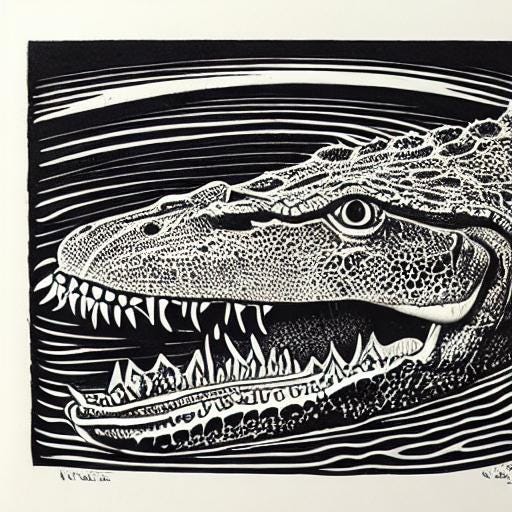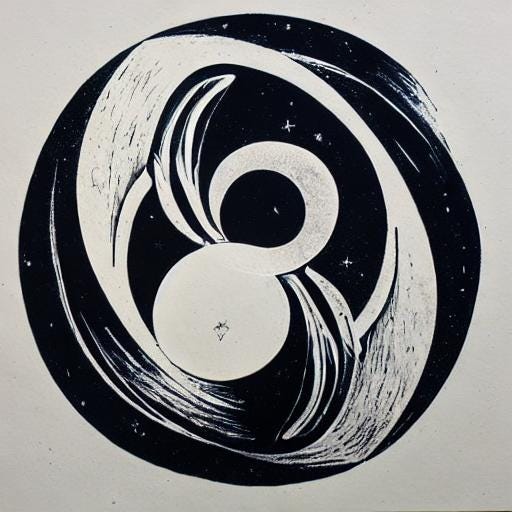Intro
Sambhava is the origin story of the Kuru dynasty.
https://crackpot.substack.com/t/sambhava
As It Rhymes
1-2.
Drona smiled and said,
‘Your turn, Dhananjaya.
On my mark, aim then let go.’
3.
With Drona on his shoulder, Savyasachi drew his bow.
4.
Drona leaned in near to put his question in Arjuna’s ear.
‘What do you see? The bird, trees, kin or me?’
6-7.
Partha said,
‘I do not see you nor the tree.
I do not see the body nor wing.
My mind sees one thing.’
8.
Drona’s body hair goose bumped.
Drona said,
‘Let it rip.’
Arjuna slipped his grip.
Arjuna’s bow pumped.
9.
The bow tanged as the sharp iron blade cut the air with a zing.
In the next moment the severed fake bird head fell to their feet.
10.
Drona felt his head swell in a dizzy spell.
With Arjuna as Drona’s ace from space, King Drupada’s cards were beat.
Notes
Chapter 25
[1] Vaishampayana, Janamejaya ibid.
[4] Savyasachi is Arjuna. Arjuna is called Savyasachi because he is ambidextrous with the bow and shoots equally well from both sides.
[10] For commentary exploring the potential significance of Drona’s test and Arjuna’s response -
Bird's Eye View
Drona decided to test his pupils. He placed an artificial bird in a tree top. Drona placed Duryodhana and his brothers and all the other princes. He asked them one after another the same question, but they all replied as did Yudhishthira. ‘Do you see the tree, me, the others and the bird?’
[11-23] Redacted the story of Drona and the crocodile.
Intermission
- for the Mahabharata’s Ghoshayatra and Sambhava As It Rhymes parvas in progress.
In Ghosha, Duryodhana and crew have been bested by musicians in a fight at Lake Dvaitavana. In Sambhava, we are get the origin story of the epics characters and the kernel of enmity that drives the dynasty to extinction.
https://crackpot.substack.com/t/ghosha
https://crackpot.substack.com/t/sambhava
Related Recommendation
A relation shares a cache of the Amar Chitra Katha comics. These are beloved in India, but may not be as known in western countries. Made at the same time and in the same style as classic Steve Ditko, Jack Kirby, etc. style comic art. a treat. The above depiction of Arjuna and Krishna. Arjuna’s cocksure pose & cocky prose. Krishna’s Cheshire Cat grin. 🤭
Digging deeper - The demonic Asuras are dark skinned. Devas (celestials) are light skinned. In ACK Krishna and Arjuna are light blue skinned, but in the epic Arjuna explains he is called Arjuna because arjuna means white and he the light skinned Pandava. Vasudeva Kesava is nicknamed Krishna because he is as dark as a full thunder cloud. Krishna is sometimes depicted as dark blue. Blue tint fades in time so Krishna iconography artifacts are sometimes light blue shade faded. Krishna and Arjuna may have both had a bluish hue the way either very dark or very light skin sometimes do. I riff on skin.
What may be important is to keep in mind the symbolic meaning of Krishna and Arjuna being both the black and white metaphorical meaning intact and unobscured by depiction. I think the importance of this pairing may be why the ACK comics colored Krishna and Arjuna the same shade of blue. This is important to the literature’s themeatic elements. The epic treats Arjuna and Krishna as complementary yin-yang. Each separate is a dynamo. Together they complete a package. The other characters of the story consider Krishna and Arjuna avatars of Narayana and Nara, a celestial pair linked to Vishnu. Krishna and Arjuna establish a reputation as a fighting pair in the allegorical story of the Khandava forest (the two clean out a beautiful forest infested with massive serpents and cannibals). Krishna, similar to Hercules, was the greatest charioteer of his time. Krishna expertly threaded four horses in the field of battle with his chariot where less accomplished charioteers reigned two. With Krishna as Arjuna’s charioteer in the war - the two were an unstoppable force. Duryodhana is frequently frustrated that his best fighter Drona cannot check Arjuna. Duryodhana questions if Drona intentionally lets Arjuna pass from personal affection. A last bit of interrelated trivia - at the end of the epic the Pandavas decide it is time. They decide to ascend the Himalaya mountains as their final act. Yudhishthira alone makes the ascent. The other Pandavas fall out from the seven deadly sins. Bhima’s sins are gluttony and wrath. Draupadi falls for lust. Nakula and Sahadeva’s sins are envy and greed (have to check on that.) Arjuna’s mortal sin is pride.
Newsletter Notes
This is the Sanskrit newsletter.
The Sanskrit newsletter publishes the latest word on the street in Sanskrit every Sunday.
Thanks for reading!







